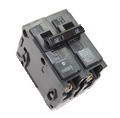|
» Home Electrical Wiring
» Electrical Wiring Directory
» Circuit Breakers and Fuses
» Need Electrical Help? Ask the Electrician
» Circuit Breakers and Fuses
» Need Electrical Help? Ask the Electrician
GFCI and AFCI Circuit Breakers
 |
Summary: Electric circuit protection with AFCI provide the extra measure of safety for your family. AFCI's are installed serving required house
wiring circuits protecting areas such as the bedrooms. AFCI protects the bedroom circuit devices against the danger of arcing which can lead to fire.
© By: Dave Rongey |
What are GFCI and AFCI Circuit Breakers?
The electric circuit breakers serving your home wiring circuits are intended for switching and protection of your home's wiring from high temperatures caused by excess current higher than the rating of the wire.
While thermal magnetic circuit breakers are the key element for overload and short circuit protection of your home electrical system, there are potentially dangerous conditions that do not involve overcurrent.
The following circuit breakers should be utilized to provide further protection with house wiring.
AFCI's can Prevent Sparks That Can Lead to a House Fire
 |
Combination Arc Fault Circuit Interrupters (AFCI)
 |
Combination AFCIs protect against all three possible types of arc fault: line to ground, line to neutral arcs, and series arcs and thus significantly reduce the risk of electrical fires. They feature a unique LED trip indicator, providing a valuable analysis tool to help to pinpoint the type of trip and reduce the time spent debugging the home electrical wiring circuits. |
Branch Feeder Arc Fault Circuit Interrupters (AFCI)
 |
AFCIs are new electrical safety devices used for some of the home electrical wiring circuits that provide protection against arcing faults. These devices recognize characteristics unique to arcing and de energize the circuit when an arc fault is detected. Arc faults may occur for many reasons such as worn electrical insulation or damaged wire, misapplied or damaged appliance cords and equipment, loose electrical connections, or driving a nail into a wall and having it inadvertently hit a wire. The possibility of arcing grows as a home ages since age and time will contribute to the possibility of these conditions occurring. |
Circuit Breakers and Surge Arresters
 |
One example of a circuit breaker with a built in surge arrestor is this transient voltage surge suppressor (TVSS) module which has a highly effective surge suppressor integrated with two 1-pole circuit breakers. Even the best point-of-entry surge protectors are subject to failure in the event of a catastrophic surge. Good surge protectors are designed to sacrifice themselves and not the connected equipment. Some surge protection devices provide visual indication that the surge protection circuitry is functional and protecting the connected equipment. If the indicator lights are not illuminated the home owner should replace the surge protector promptly. |
Common Brands of Home Electrical Circuit Breakers |
|
|















